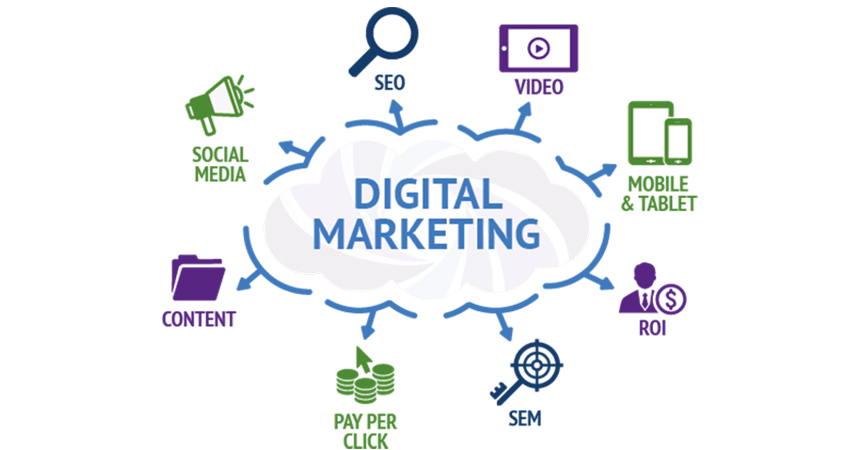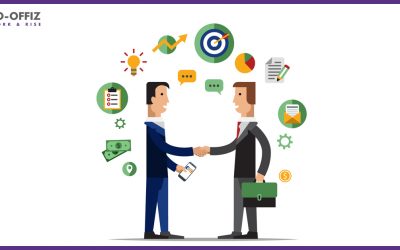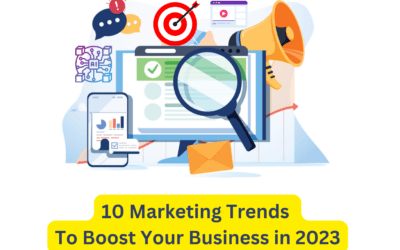A Digital Marketing Era
What is Digital Marketing?
Digital marketing is an umbrella term that encompasses most of our web-based advertising efforts. It refers to the promotion of goods and services through various digital channels, with the primary goal of enhancing brand visibility and driving business growth.
Organizations leverage platforms such as search engines, social media, email, and websites to connect with current and potential customers. In simple terms, digital marketing uses digital technologies to showcase products and services, enabling businesses to reach a broader audience quickly and efficiently.
In today’s world, digital marketing has become more important than ever as consumers are increasingly shifting toward online platforms for their daily needs. This trend has presented immense opportunities for businesses to enhance their marketing efforts through digital channels.
Growth of Digital Marketing
Since the early 2000s, digital marketing has experienced explosive growth, revolutionizing the way brands and organizations use technology for marketing. With the rise of the internet and mobile phones, the way people shop, socialize, and consume media has drastically changed. As consumers spend more time online, digital marketing has opened new avenues for businesses to reach their audience and engage with them effectively.
Take Amazon, for example. Over the years, Amazon has leveraged digital marketing strategies such as search engine optimization (SEO), content marketing, and email marketing to dominate the e-commerce space. Their ability to personalize recommendations and engage with users through digital channels has made them one of the biggest brands in the world.
Basics of Digital Marketing
Digital marketing is not just about placing ads on websites or posting on social media; it’s a multifaceted approach that involves a variety of strategies. To be successful, businesses must implement a combination of tactics, each playing a specific role in achieving their marketing goals. Below are some of the most effective and widely used digital marketing techniques:
1. Search Engine Optimization (SEO)
SEO is the process of improving your website’s visibility on search engines like Google, Bing, and Yahoo. It’s an organic strategy that involves optimizing your website’s content, structure, and technical elements to achieve higher rankings in search results.
Example: If you run a bakery, you would optimize your website for keywords like “best cakes in [city name]” or “order birthday cakes online.” By doing so, when someone searches for these terms, your bakery will appear higher in search results, driving more traffic to your site.
SEO requires continuous efforts to stay up to date with search engine algorithms and trends. Tools like Google Analytics and SEMrush can help you monitor your SEO performance and track keyword rankings.
2. Content Marketing
Content marketing is all about creating valuable, relevant, and consistent content to attract and engage your target audience. Whether it’s blog posts, videos, infographics, or podcasts, content marketing helps businesses build authority, trust, and customer loyalty over time.
Example: HubSpot is a great example of content marketing done right. They provide a wide range of resources, including blogs, guides, eBooks, and webinars, to educate their audience about inbound marketing. This content not only attracts new customers but also helps establish HubSpot as an industry leader.
Content marketing also involves content distribution. Sharing your content on social media platforms, email newsletters, or other channels ensures that your audience gets to see and interact with your content.
3. Inbound Marketing
Inbound marketing focuses on attracting customers through valuable content rather than pushing ads to them. By creating content that addresses customers’ pain points and offering solutions, businesses can attract leads and build relationships over time.
Example: If you’re a software company offering project management tools, you could create blog posts, videos, and downloadable guides on topics like “how to improve team productivity” or “best project management practices.” These resources would attract potential customers who are searching for solutions to their challenges, guiding them toward your product.
Inbound marketing emphasizes long-term relationships with customers, making it one of the most effective and cost-efficient marketing strategies.
4. Social Media Marketing
Social media marketing (SMM) involves using platforms like Facebook, Instagram, Twitter, and LinkedIn to promote your brand. By creating engaging content, businesses can reach a wider audience and encourage user interaction through likes, shares, and comments.
Example: A fashion brand like Zara effectively uses Instagram to showcase new collections and engage with their audience. They post visually appealing images and videos, encourage user-generated content, and interact with customers in the comments section. This builds brand awareness and loyalty while also driving traffic to their website.
Social media allows businesses to target specific audiences based on interests, demographics, and online behavior, making it one of the most effective ways to reach potential customers.
5. Pay-Per-Click (PPC)
PPC is a paid advertising model where advertisers pay each time a user clicks on their ad. Google Ads, Facebook Ads, and LinkedIn Ads are some of the most popular PPC platforms. Unlike SEO, which relies on organic search rankings, PPC allows businesses to instantly place their ads in front of their audience.
Example: A local restaurant could use Google Ads to target people in their area searching for “best pizza near me.” By bidding on specific keywords, the restaurant can ensure its ad appears at the top of the search results when users search for those terms.
PPC offers businesses immediate results and valuable data to fine-tune their campaigns for better performance.
6. Affiliate Marketing
Affiliate marketing is a performance-based marketing model where businesses pay affiliates for generating traffic or sales through their marketing efforts. Affiliates promote products or services and earn a commission for each successful sale or lead.
Example: Amazon Associates is a well-known affiliate program. Bloggers, YouTubers, and influencers can promote products on Amazon through affiliate links, earning a commission for every purchase made through those links.
Affiliate marketing is a low-risk, high-reward strategy that allows businesses to extend their reach through third-party marketers.
7. Marketing Automation
Marketing automation uses software to automate repetitive marketing tasks like sending emails, scheduling social media posts, and managing customer data. By automating these tasks, businesses can save time and deliver personalized experiences at scale.
Example: Mailchimp, a popular email marketing tool, helps businesses automate their email campaigns by segmenting customers and sending targeted messages based on user behavior, such as abandoned cart emails or birthday promotions.
Marketing automation helps businesses nurture leads and maintain customer engagement without manual intervention.
8. Email Marketing
Email marketing remains one of the most effective ways to communicate with customers. Whether it’s newsletters, promotions, or product updates, email marketing allows businesses to stay connected with their audience directly.
Example: Starbucks uses email marketing to send personalized offers and rewards to their customers through their loyalty program. These emails encourage customers to make repeat purchases, driving customer retention.
Email marketing, when done correctly, can significantly boost sales and customer loyalty.
AI: Transforming the Digital Marketing Landscape in 2025
As we move deeper into the digital age, one of the most significant game-changers in the world of digital marketing is artificial intelligence (AI). In 2025, AI is set to play an even more dominant role in shaping marketing strategies and automating processes to improve efficiency and customer experience.
AI tools like machine learning, natural language processing, and predictive analytics are revolutionizing how businesses create personalized experiences for their customers. For instance, AI can analyze vast amounts of data from consumer behavior and preferences to recommend personalized content, offers, and product suggestions. This level of personalization was previously unattainable, but with AI, businesses can connect with their audience in ways that feel more authentic and relevant.
Example: Netflix is a prime example of how AI transforms user experience. Their recommendation engine uses AI to analyze user preferences and viewing history to suggest content that’s likely to be of interest. This increases user engagement, reduces churn, and enhances customer satisfaction.
AI also enables chatbots and virtual assistants to engage with customers in real time, providing instant support and improving the overall customer experience. Chatbots are already being used by companies like H&M and Sephora to offer personalized product recommendations, help with customer queries, and guide customers through the purchasing process.
In 2025, businesses will increasingly rely on AI to automate repetitive tasks such as ad targeting, content creation, and customer service, making digital marketing efforts more efficient and scalable.
Rise of Mobile Marketing
Mobile marketing has become a vital component of digital marketing. With mobile usage accounting for over 60% of digital media consumption, businesses need to optimize their marketing efforts for mobile devices. From mobile-friendly websites to apps and SMS marketing, mobile marketing ensures that your audience can engage with your brand no matter where they are.
Example: Uber is a prime example of how mobile marketing works. The company relies heavily on its mobile app to provide a seamless experience for users, from booking a ride to making payments. Uber’s app is optimized to cater to mobile users, offering convenience and ease of use.
Conclusion: AI in Digital Marketing
In conclusion, digital marketing is no longer optional; it’s a necessity for businesses looking to thrive in today’s competitive landscape. With strategies like SEO, content marketing, social media marketing, and mobile optimization, businesses can effectively reach and engage their audience. The rise of AI in digital marketing is further revolutionizing the way businesses interact with customers, enabling deeper personalization, greater efficiency, and more meaningful relationships.
As we approach 2025, businesses that embrace these technologies will lead the way in the evolving digital landscape. The digital marketing era is here, and businesses that embrace these strategies will continue to thrive.
About CO-OFFIZ : Coworking Space in Delhi-NCR
Co-offiz is a coworking space in Delhi-NCR tailored for young professionals, startups, freelancers, and entrepreneurs. We emphasize a collaborative work culture that enhances productivity while providing a hassle-free and aesthetically pleasing environment based on Vastu principles.
Our modern amenities include high-speed internet, unlimited tea/coffee, breakout zones, power backup, and CCTV security. Our vibrant meeting rooms feature LED TV projectors and ergonomic chairs, fostering an ideal workspace.
With locations in in Preet Vihar (East Delhi), Janakpuri (West Delhi), Netaji Subhash Place (North Delhi), Noida Sec-63 and Gurugram Sec-58, we offer flexible seating, dedicated desks, and private cabins at competitive prices, all conveniently located near metro stations for easy access.



